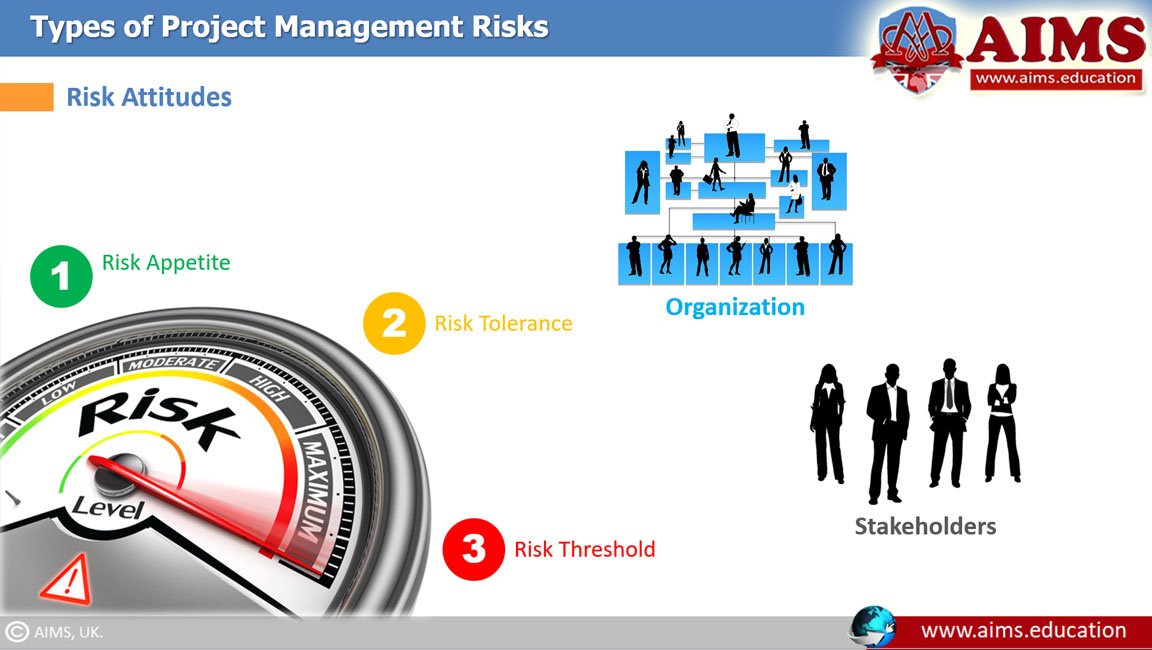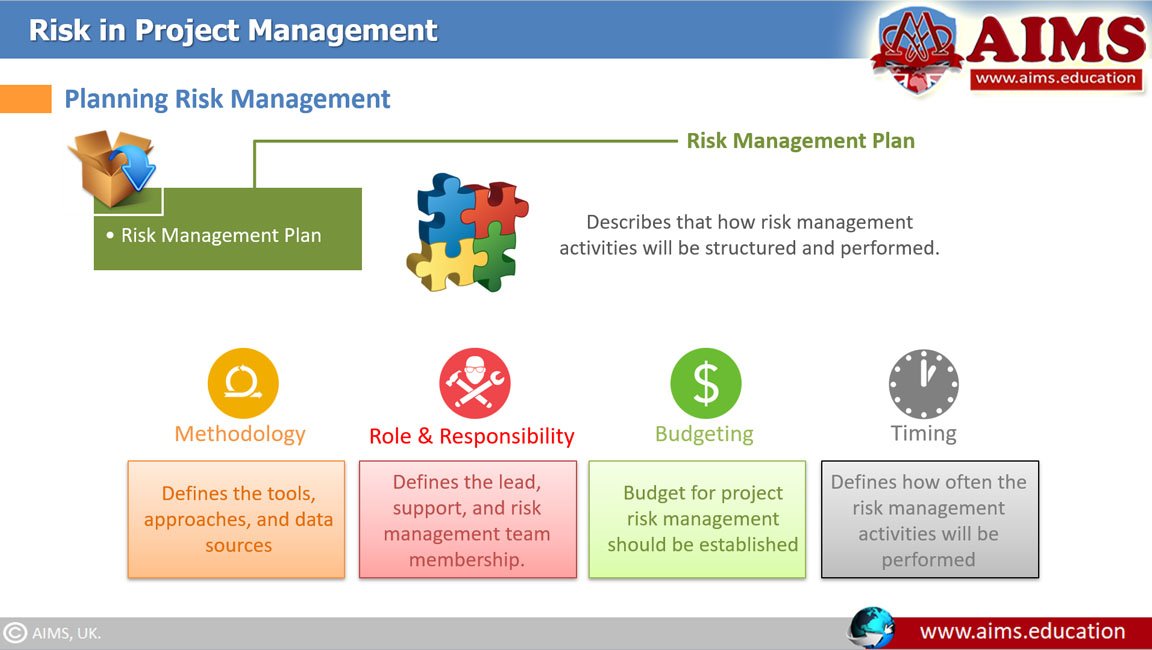What is Project Risk Management?
Project risk management is an activity that manages the risks of your project. It includes the processes of planning, identifying, analyzing, responding, and controlling project risks. The goal of managing risk in project management is to be more proactive and less reactive. The objectives of project risk management are to increase the likelihood and impact of positive events and decrease the likelihood and impact of negative events in the project.
What is a Risk?
A risk is an uncertain event that could positively or negatively affect your project. The possibility of an uncertain event in a project is between 1 to 99%.
- There is no risk if there is a 0% chance of an event occurring.
- If there is a 100% chance of an event occurring, this would be an issue, not a risk.
“Here are some key notes related to project management risk:
- Risks with negative consequences are called “Threats”.
- Risks with positive consequences are called “Opportunities”.
- The project management risk can be good or bad. So, stop thinking of risk as bad only and start thinking of it in terms of probabilities.”.
Key Note
Importance of Project Risk Management
- During the project management risk, the role of project manager is not to focus on dealing with problems but to focus on preventing them.
- It helps avoid many problems and stops the emergence of other issues.
- Project risk management helps prepare for many problems and develop a strategy for handling them.
Types of Project Risks
Project management risks can be divided into several types, which are given below:
1. Pure Risk or Hazard
These are the project risks with potential loss only. For example: Fire, theft, personal injury, etc.
2. Business or Speculative Risk
These types of risks result in potential loss or gain. Here are some examples:
- Highly skilled employees who may reduce your schedule time become available to work on your project.
- Change in tax rates.
- A new server that costs more than you budget, resulting in increased efforts and project management costs.
3. Known and Unknown Risks
Risks exist in all projects, and they could be known or unknown.
- Known Project Management Risks are those that have been identified and analyzed. Project managers are already aware of them, and they can respond to them when they occur.
- Unknown Project Management Risks cannot be managed. Project managers may use their past experiences with similar projects to address and handle those project risks.
Project Risk Management is an essential part of the AIMS’ online project management certification, diploma in project management online (MDPM), and the accredited MBA in Project Management online programs. During these programs, students learn to plan and implement risk in project management, program management, and project portfolio management.

Project Management Risk Attitudes
Several factors may influence the risk attitudes of the organization and the stakeholders. These factors are broadly classified into three themes:
- Risk Appetite,
- Risk Tolerance, and,
- Risk Threshold.
1. Risk Appetite
Risk appetite is the degree of uncertainty that an entity is willing to take on in anticipation of a reward. In other words: “Organizations are willing to accept risks to grow themselves”. There are certain levels of risk appetite.
For Example
- If an organization is willing to take a risk, we will say that its risk appetite is high.
- Those organizations that play conservatively have a low-risk appetite.
2. Risk Tolerance
It is the degree to which an entity is willing to accept project management risks. In other words: “Organizations may accept risks if they are within their tolerance.” So, the risks should be balanced with the rewards.
For Example
An organization may allow schedule slippage of 5 to 10% or Cost Slippage of 3 to 5%. So, these levels are the Risk Tolerance of the organization.
3. Risk Threshold
It is a further step in the risk tolerance process. The Risk threshold quantities the risk tolerance in a more precise way. In risk tolerance, you have limits, but in risk threshold, you have a precise figure.
For Example
During project management, an organization cannot allow taking a risk, such as a slippage of more than $10,000.
- Below that risk threshold, the organization will accept the risk.
- Above that risk threshold, the organization will not tolerate the risk.

6 Steps in the Project Risk Management Processes
The project management risk is managed by following six steps. These are called project risk management processes, and they are:
- Plan Risk Management,
- Identify Risks,
- Perform Qualitative Risk Analysis,
- Perform Quantitative Risk Analysis,
- Plan Risk Responses, and,
- Control Risk.
Step 1: Plan Risk Management
It is the project risk management process of establishing the policies, procedures, and documentation for performing project management risks. The purpose of a risk management plan is to help you identify, evaluate, and plan possible risks that may arise within the project management process.
Key Benefit
A Plan Risk Management process ensures that the degree, type, and visibility of project management risks are proportionate to both the risks and the project’s importance to the organization.
Step 2: Identify Risks
This project risk management process determines which risks may affect the project and documents the characteristics of each risk that can keep an organization or program from reaching its project management objective.
Key Benefit
This process documents the existing risks and enhances the knowledge and ability of the project team to anticipate events. Here are the key participants of Risk Identification Activities:
- Project manager.
- Project team members.
- Risk management team, if assigned.
- Customers.
- Subject matter experts from outside the project team.
- End users.
- Other project managers.
- Stakeholders; and,
- Risk management experts.
Step 2: Perform Qualitative Risk Analysis
It is the process of identifying the project management risks and assessing their probability and impact using a qualitative method. Note that during the identify risks process, individual project risks are identified. These identified risks are then analyzed in two ways:
- Qualitatively, and,
- Quantitatively.
“Qualitative Risk Analysis” is the process of prioritizing risks for further analysis or action. It is done by accessing and combining project management risks’ probability of occurrence and their impact.
It is called qualitative because it is based on the project team’s subjective perceptions of risk.
Key Benefit
Once you have a priority list, you can focus the team’s efforts on high-priority risks.
Step 4: Perform Quantitative Risk Analysis
Perform Quantitative Risk Analysis is the 4th project risk management process of numerically analyzing the effect of identified risks on overall project objectives. At this stage, the project management risks are identified, probability is assessed, and the impact of identified risks is calculated using the quantitative method.
Key Benefits
This process produces quantitative risk information, which supports decision-making to reduce project uncertainty.
Key Objectives of Performing Quantitative Risk Analysis
The purpose of this process is to quantify possible outcomes and probabilities of the project. The analysis is done with the following objectives:
- Determine the probability of achieving the project objectives.
- Identify risks that need the most attention by quantifying their contribution to overall project risk.
- Identify realistic and achievable schedule, cost, or project scope targets.
- Determine the best possible project management decisions, when outcomes are uncertain.
Step 5: Plan Risk Responses
Risk response planning is the project risk management process that develops options and determines actions to enhance opportunities and reduce threats to the project`s objectives. The risk planning process in projects includes the identification and assignment of individuals or parties to take responsibility for each risk response.
Key Benefits
The main objectives of this project risk management process are:
- Address the risks by their priorities,
- Schedules the project management plan as required, and,
- Inserts resources and activities into the budget.
Step 6: Control Risks
It is a project risk management process that implements risk response plans, tracks identified risks, monitors residual risks, identifies new risks, and evaluates risk process effectiveness throughout the project.
Key Benefit
The control risk process improves the efficiency of the project management risk approach throughout the project management phases so that the risk responses can be optimized.

7 Key Benefits of Risk Management in Project Management
Risk management in project management isn’t just about playing defense—it’s about setting your project up for success from the project management initiation phase. Project risk management can make a huge difference in how smoothly things go. It can help you manage project time, project costs, and project resources.
Here are the key benefits of project risk management:
1. Helps You Stay on Track
By identifying project management risks early, you’re not waiting for problems to pop up; you’re already ready for them. It will keep your project on schedule and within budget.
2. Help in Project Resource Management
Project risk management forces you to focus your efforts to avoid potential issues. You won’t waste project management resources or efforts without accessing them on tasks or matters that may cause risks.
4. Better Decision Making
When you know what risks are on the horizon, you can prioritize your project management tasks, allocate resources, and adjust project management strategies accordingly.
5. Boosts Project Stakeholder’s Confidence
When clients or other stakeholders see that you’re on top of potential project management risks, they feel more comfortable about your ability to deliver your project. This leads to stronger relationships with project stakeholders and leads to project management success.
6. Keeps Your Projects in Control
When you are able to identify your project risks earlier and manage them on time, you take control of your project. Project risk management allows a project manager to actively keep an eye on what project management risks may arise and how to handle those issues.
7. Help in Project Cost Management
By addressing project risks before they become serious issues, project managers can avoid costly mistakes. Project risk management can save you a significant amount of money by preventing expensive delays or rework.
